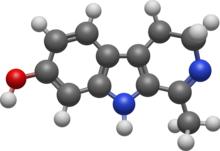Chemistry:Harmalol
From HandWiki

| |

| |
| Names | |
|---|---|
| Preferred IUPAC name
1-Methyl-4,9-dihydro-3H-pyrido[4,3-b]indol-7-ol | |
| Other names
1-Methyl-4,9-dihydro-3H-β-carbolin-7-ol
| |
| Identifiers | |
3D model (JSmol)
|
|
| ChemSpider | |
| EC Number |
|
PubChem CID
|
|
| UNII | |
| |
| |
| Properties | |
| C12H12N2O | |
| Molar mass | 200.241 g·mol−1 |
| Appearance | Red solid |
| Melting point | 100 to 105 °C (212 to 221 °F; 373 to 378 K) (trihydrate)[1] |
Except where otherwise noted, data are given for materials in their standard state (at 25 °C [77 °F], 100 kPa). | |
| Infobox references | |
Tracking categories (test):
Harmalol is a bioactive beta-carboline and a member of the harmala alkaloids.[2][3]
Legal status
Australia
Harmala alkaloids are considered Schedule 9 prohibited substances under the Poisons Standard (October 2015).[4] A Schedule 9 substance is a substance which may be abused or misused, the manufacture, possession, sale or use of which should be prohibited by law except when required for medical or scientific research, or for analytical, teaching or training purposes with approval of Commonwealth and/or State or Territory Health Authorities.[4]
See also
References
- ↑ Thieme Chemistry (Hrsg.): RÖMPP Online – Version 3.37. Georg Thieme Verlag KG, Stuttgart, 27. September 2013.
- ↑ "Binding of alkaloid harmalol to DNA: photophysical and calorimetric approach.". J Photochem Photobiol B 130: 272–80. 2014. doi:10.1016/j.jphotobiol.2013.11.021. PMID 24368411.
- ↑ "Harmaline and harmalol inhibit the carcinogen-activating enzyme CYP1A1 via transcriptional and posttranslational mechanisms.". Food Chem Toxicol 50 (2): 353–62. 2012. doi:10.1016/j.fct.2011.10.052. PMID 22037238.
- ↑ 4.0 4.1 Poisons Standard October 2015 https://www.comlaw.gov.au/Details/F2015L01534
 |

